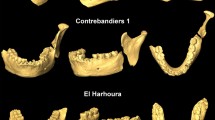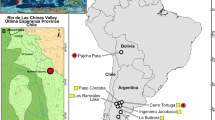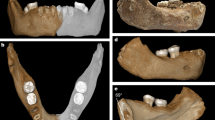Abstract
ARCHAEOLOGICAL excavations at the mediaeval site of Dmanisi (East Georgia) revealed that the town was built on a series of deposits yielding Late Villafranchian mammalian fossils and led to the discovery in late 1991 of a well preserved early human mandible. Dmanisi, where excavations are being carried out by a joint expedition of the Archaeological Research Centre of the Georgian Academy of Sciences and the Römisch-Germanisches Zentralmuseum (Mainz, Germany), is located southwest of Tbilisi, at about 44o 20' N, 41o 20' E (Fig. 1). The fossils date to the latest Pliocene (or perhaps to the earliest Pleistocene), probably between 1.8 and 1.6 million years ago (Myr). Here we identify the mandible as belonging to the species Homo erectus, of which it is the earliest known representative in western Eurasia. It shows a number of similarities to the African and Chinese representatives of this species.
This is a preview of subscription content, access via your institution
Access options
Subscribe to this journal
Receive 51 print issues and online access
$199.00 per year
only $3.90 per issue
Buy this article
- Purchase on Springer Link
- Instant access to full article PDF
Prices may be subject to local taxes which are calculated during checkout
Similar content being viewed by others
References
Majsuradze, G., Pavlenshvili, E., Schmincke, H. & Sologashvili, D. Jahrb. Römisch-German. Zentralmus. 36, 74–76 (1991).
Bosinski, G., Lordkipanidze, D., Majsuradze, G. & Tvaicrelidze, M. Jahrb. Römisch-German. Zentralmus. 36, 76–83 (1991).
Muskhelishvili, A. Jahrb. Römisch-German. Zentralmus. (in the press).
Gabunia, L & Vekua, A. Dmanisi Man and the Accompanying Vertebrate Fauna 1–60 (Metsniereba, Tbilisi, 1993).
Sologashvili, D., Majsuradze, G., Pavlenshvili, E. & Klopotovskaja, N. Jahrb. Römisch-German. Zentralmus. (in the press).
An, Z. & Ho, C. K. Quat. Res. 32, 213–221 (1989).
Swisher, C. C. et al. Science 263, 1118–1121 (1994).
Verosub, K. L. & Tchernov, E. In Les Premiers Européens (eds Bonifay, E. & Vandermeersch, B.) 237–242 (Comité Travaux Historiques Scientifiques, Paris, 1991).
Roebroeks, W. Curr. Anthropol. 35, 301–305 (1994).
Wood, B. A. Koobi Fora Research Project, vol. 4: Hominid Cranial Remains (Clarendon, Oxford, 1991).
Walker, A. & Leakey, R. in The Nariokotome Homo erectus Skeleton (eds Walker, A. & Leakey, R.) 63–94 (Harvard Univ. Press, 1993).
Weidenreich, F. Palaeontol. Sinica n.s. D1, 1–180 (1937).
Rightmire, G. P. The Evolution of Homo erectus (Cambridge Univ. Press, 1990).
Brown, B. & Walker, A. in The Nariokotome Homo erectus Skeleton (eds Walker, A. & Leakey, R.) 161–192 (Harvard Univ. Press, 1993).
Bosinski, G., Bugianisvili, T., Mgeladze, N., Nioradze, M. & Tusabramisvili, D. Jahrb. Römisch-German. Zentralmus. 36, 93–107 (1991).
Author information
Authors and Affiliations
Rights and permissions
About this article
Cite this article
Gabunia, L., Vekua, A. A Plio-Pleistocene hominid from Dmanisi, East Georgia, Caucasus. Nature 373, 509–512 (1995). https://doi.org/10.1038/373509a0
Received:
Accepted:
Issue Date:
DOI: https://doi.org/10.1038/373509a0
This article is cited by
-
Modern phytolith assemblages as indicators of vegetation in the southern Caucasus
Vegetation History and Archaeobotany (2023)
-
Unity in diversity—food plants and fungi of Sakartvelo (Republic of Georgia), Caucasus
Journal of Ethnobiology and Ethnomedicine (2021)
-
Oldowan stone knapping and percussive activities on a raw material reservoir deposit 1.4 million years ago at Barranco León (Orce, Spain)
Archaeological and Anthropological Sciences (2021)
-
A genotype:phenotype approach to testing taxonomic hypotheses in hominids
The Science of Nature (2020)
Comments
By submitting a comment you agree to abide by our Terms and Community Guidelines. If you find something abusive or that does not comply with our terms or guidelines please flag it as inappropriate.



